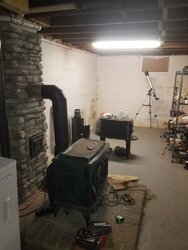I am installing a new stove. It needs 20 inches clearance off the sides. I will only have 17 inches on one side due to the fact that on that on one side there is a steel sided dryer. Does this count as a flammable (being steel) I will also need ceiling protection. 7 ft ceiling minimum and I have 6 ft 4 to the ceiling joists. Will a layer of sheet metal with a 1 inch gap suffice?
Last edited:



 love see the rock mortared so cleanly.
love see the rock mortared so cleanly.